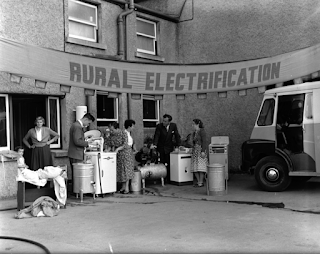5 November 1946: The start of the Rural Electrification Scheme in the Irish Free State on this day. This major project began in a field at Kilsallaghan in north county Dublin[above]. Kilsallaghan was the 1st rural area in Ireland out of 792 so designated to receive electricity under the scheme. The Rural Electrification Scheme employed up to 40 separate units of 50-100 workers, spread across 26,000 square miles. By November 1961 280,000 rural premises were connected, at a cost of over £30,000,000. The purpose was to roll out the benefits of electricity to every household and farm in the State. The task was entrusted to the Electricity Supply Board (established 1927) and the mammoth task entailed the purchase over one million wooden poles from Finland. Over 75,000 miles of wire were also needed.
‘The electrification of rural Ireland had been envisaged since work first began on the Shannon Scheme in 1925. Dr Thomas McLaughlin, the founding father of ESB, believed that rural electrification represented ‘the application of modern science and engineering to raise the standard of rural living and to get to the root of the social evil of the “flight from the land”.
‘However, the financial resources were not available to extend electricity to rural Ireland in the first days of the newly formed Irish free state and in the 1920s and 1930s. Electricity from the Shannon Scheme was supplied to roughly 240,000 premises in towns and cities only, leaving over 400,000 rural dwellings without power. In the late 1930s and early 1940s, ESB and the government began working on broad plans for rural electrification, and the state agreed to subsidise its roll out. However, the outbreak of World War II in 1939 delayed the process, and work could not start on the scheme until after its end in 1945.’...The last area to receive electricity was the remote area of Blackvalley, Co. Kerry, in 1978.
https://esbarchives.ie/2016/03/23/life-before-and-after-rural-electrification/
The benefits of electricity was of course huge. It was something that just about every home and farmstead in the State wanted with only the very odd one refusing to be connected. Up until then the managing of a household or farm had been a hugely labour intensive operation for both men and women. Everything from cooking to washing to heating was pure manual work.
‘Activity on the farm and in rural households was dictated by the availability of daylight. After dark, limited lighting was provided by oil lamps or candles. Water had to be drawn from a well, and carried home by foot or by cart. Clothes had to be washed by hand, or with a hand-powered ‘wringer washer’. Heating and cooking depended on solid fuel, such as timber and turf, often cut and harvested by the family. Cooking was confined to an open hearth or range. Food safety was difficult to ensure without any form of refrigeration, a particular difficulty on the farm and in the dairy. Industrial development was not feasible without a supply of electricity.’
https://esbarchives.ie/2016/03/23/life-before-and-after-rural-electrification/
Today we live in a world where the lack of electricity in our daily lives is unthinkable. But there are still Irish households today where the oil lamp is not a source of curiosity but a memento of a time when they could not make their way about their house after dark without one.

.png)
No comments:
Post a Comment